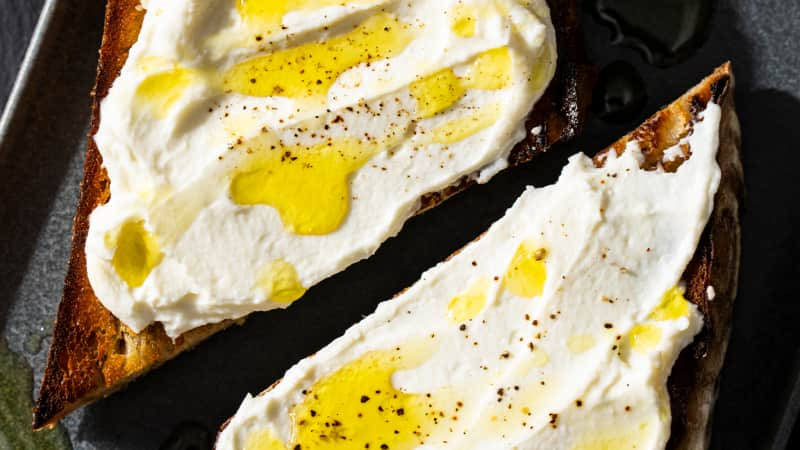Making ricotta cheese at home sounds like it could be difficult, but it is surprisingly easy . . . and, when done right, the results are so much better than store-bought versions. It’s the kind of thing you can eat on its own, right off the spoon. If you’ve ever had freshly made ricotta, you know what I mean. And if you haven’t, well, you’re in for a treat.
How to Make Rich, Creamy Ricotta Cheese at Home
Published May 10, 2022.

Ricotta is typically made by just heating milk with a little salt, adding lemon juice or vinegar to separate the dairy into curds (solids) and whey (liquid), and then draining off the whey.
Sign up for the Notes from the Test Kitchen newsletter
Our favorite tips and recipes, enjoyed by 2 million+ subscribers!
This is a great starting point. But we wanted the ultimate version of homemade ricotta: extra-tender curds; a rich, light, spreadable texture; and clean dairy flavor with a little tang. We tested different variables until we’d eliminated all grainy, bouncy, and rubbery versions, landing on our ideal.
Here are the keys to making ricotta cheese at home.
- For extra-tender curds, do not overheat the milk (185 degrees is optimal). If the milk is too hot, it will overcook and toughen the curds.
- To ensure that the dairy flavor comes through but the cheese still has a noticeable tang, use just the right ratio of acid to milk (we landed on ¼ cup vinegar to 8 cups whole milk).
- Because warm ricotta will be soupy, don’t worry about its texture right after draining off the whey. Chill the curds to get the right consistency.
- For an absolutely luscious texture, puree the chilled curds in the food processor to break down the larger ones.
- For a light and spreadable cheese with a little dairy sweetness, add some heavy cream to the food processor.
Homemade Creamy Ricotta Cheese
Makes about 2 cups
Do not use ultra-pasteurized (UHT) milk or cream in this recipe. Use a large fine-mesh strainer to drain the ricotta. If you don't have one, you can also use a colander lined with a single layer of cheesecloth, but you might need to stir longer in step 4 to drain off 5½ cups of whey. This recipe yields a creamy ricotta cheese with much smaller curds than many other homemade versions.
- 8 cups whole milk
- ¾ teaspoon table salt
- ¼ cup distilled white vinegar
- ¼–½ cup heavy cream
1. Set large fine-mesh strainer over large bowl. Heat milk and salt in large saucepan over medium-high heat, stirring frequently with rubber spatula to prevent scorching, until milk registers 185 degrees.
2. Remove saucepan from heat. Add vinegar and stir until mixture curdles, about 10 seconds. Let sit, undisturbed, until mixture fully separates into curds and cloudy whey, about 5 minutes.
3. Using ladle, transfer curds and whey to prepared strainer. Let sit until most of whey has drained from ricotta but center is still moist, about 10 minutes.
4. Using rubber spatula, stir ricotta in strainer, gently scraping sides and bottom of strainer, until any excess whey has drained from ricotta, about 30 seconds (you should have at least 5½ cups whey; if not, continue to stir until you have 5½ cups whey). Discard whey. Transfer ricotta to airtight container and refrigerate until cold, about 2 hours.
5. Process ricotta and ¼ cup cream in food processor until ricotta is uniformly smooth and spreadable, about 1 minute, scraping down sides of bowl as needed. (Finished ricotta should have texture of buttercream frosting.) If ricotta is too stiff, add remaining cream, 1 tablespoon at a time, and pulse until desired consistency is achieved. Serve.
To Make Ahead: Ricotta can be refrigerated for up to 5 days; stir to recombine before using.
How to Use Homemade Creamy Ricotta Cheese
Now that you’ve made this ultimate version of ricotta, you might be wondering what to do with it.
The fastest way to serve it up, besides eating it right off the spoon (no judgment), is to make crostini. Spread a little of the ricotta (seasoned first if you’d like) over toasted slices of baguette and think of it as a blank canvas. You could top it with peas and mint, olives and sun-dried tomatoes, cherry tomatoes and basil, or any combination of ingredients that appeals to you.
Ricotta Crostini with Peas and Mint
A delightful spring crostiniHave a little more patience (and time)? Use the ricotta in lasagna or make some stuffed shells.
You could also simply dollop the ricotta on top of your favorite pasta dish. Or try our Baked Ricotta Chicken, a weeknight hit.
Baked Ricotta Chicken
Could we transform a complicated stuffed-chicken dish into a weeknight favorite?And don’t forget about breakfast! Ricotta is amazing in some cannoli-inspired stuffed French toast, and it adds richness to cheese blintzes.
Ricotta-Stuffed French Toast for Two
This decadent breakfast-in-bed treat is inspired by two desserts.Whatever you do, be sure to use it up (that won’t be a problem, right?) because ricotta does not freeze well. It will separate upon thawing and become less smooth and creamy. But if you simply must freeze it, transfer it to a zipper-lock bag, press out the air, seal the bag, and place it in the freezer. Thaw the ricotta in the refrigerator, and use it only in dishes where it is not the main ingredient, such as lasagna.


